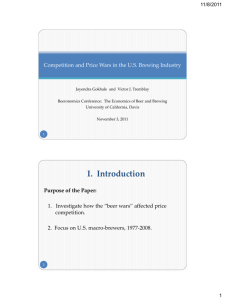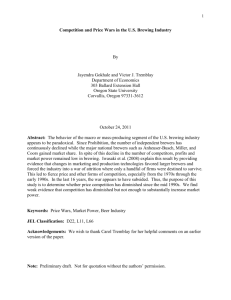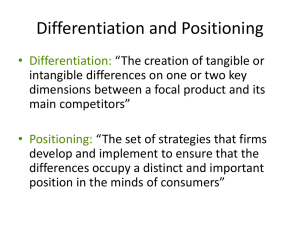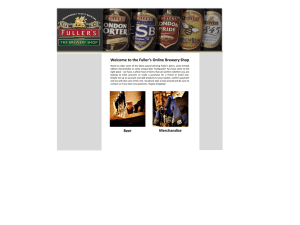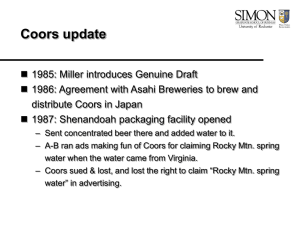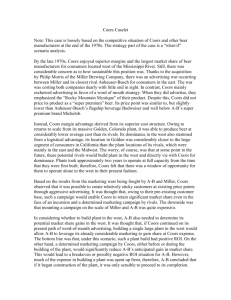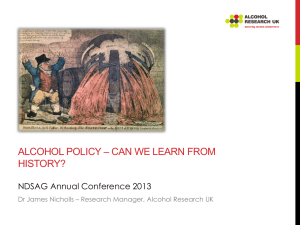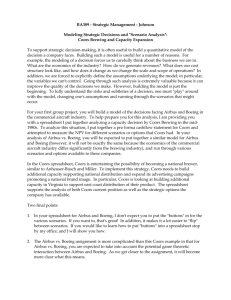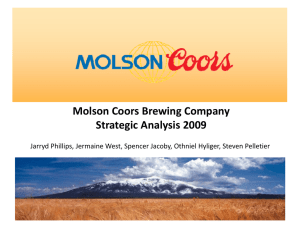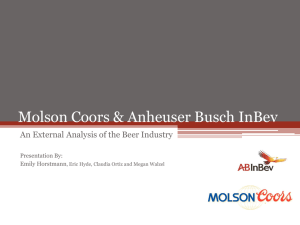Beer_P-Wars_--_UC-Davis_--_11-3
advertisement
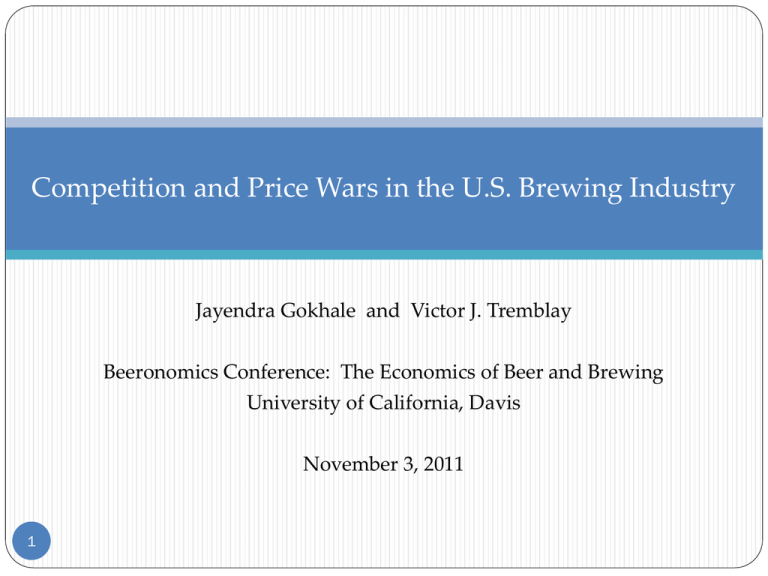
Competition and Price Wars in the U.S. Brewing Industry Jayendra Gokhale and Victor J. Tremblay Beeronomics Conference: The Economics of Beer and Brewing University of California, Davis November 3, 2011 1 I. Introduction Purpose of the Paper: 1. Investigate how the “beer wars” affected price competition. 2. Focus on U.S. macro-brewers, 1977-2008. 2 II.1 Brewing Industry Paradox 1. Decline in Number of Competitors Number of Firms (N): Four-Firm Concentration Ratio (CR4): Figure 1a Figure 1 & Herfindahl-Hirschman Index (HHI) Market Share of Leaders: Figure 1b (An-Bu, Coors, Miller, Pabst) 3 Figure 1a Number of Independent Macro-Brewers, 1947-2009 450 400 350 Number of Firms 300 250 200 150 100 50 0 Year 4 Figure 1 Beer Industry Concentration (Four-Firm Concentration Ratio and Herfindahl-Hirschman Index), 1947-2009 100 90 CR4 80 HHI Index (0-100) 70 60 50 40 30 20 10 0 Year 5 Figure 1b Market Share of Leading Macro-Brewers, 1950-2009 60 50 Market Share (Percent) 40 An-Bu 30 Coors Miller 20 Pabst 10 - Year 6 II.2 Brewing Paradox 3. Simple Theory: N and Profitability ↓N → ↑Profits (prices) Cournot (1838) Model: output (q) competition 7 8 II.3 Brewing Paradox 3. Simple Theory: ↓N → ↑Profits (prices) 4. Paradox: Profits have remained low! Market Power Indices: Lerner Index: Figures 1d, 1e ₤ = price – marginal cost price Price-Cost Margin: PCM = price – average cost price 9 Figure 1d Beer Industry PCM and the “Beer Wars”, 1950-2003 0.65 0.60 0.55 0.50 0.45 0.40 0.35 Year 10 1977 1978 1979 1980 1981 1982 1983 1984 1985 1986 1987 1988 1989 1990 1991 1992 1993 1994 1995 1996 1997 1998 1999 2000 2001 2002 2003 2004 2005 2006 2007 2008 Figure 1e 0.30 0.25 11 PCM for Anheuser-Busch (A-B), Coors, and Miller, 1977-2008 0.35 A-B Coors Miller 0.20 0.15 0.10 0.05 0.00 Year II.3 Brewing Paradox 5. Why the Paradox? ↓N → ↑Profits (price) is not true! PCM data are inconsistent with “simple theory” Alternative Theories: Bertrand Model (1883): p-competition Cournot-Bertrand Model (2011): p/q-competition War of Attrition Model (1999) 12 III. Beer Wars 1. War of Attrition (Bulow and Klemperer, 1999): N firms compete in a market that will profitably support N* < N firms. (K = N – N* > 0) 2. Industry Evolution (Tremblay and Tremblay, 2005): ↓ N* and ↑ K, why? 1) Advent of TV, 1950s and 1960s (Homes with TV: 1950-9%, 1960-87%, 1970-95%) 2) Technological Change, 1970s – 1990s → ↑MES, size needed to minimize unit cost ↑MES → ↑ K Table 1 13 Table 1 The Market Share of the National Brewers, Minimum Efficient Scale (MES), the Number of Brewers (N), and the Cost-Minimizing Number of Competitors (N*) in the U.S. Brewing Industry Year Market Share of National Brewers (Percent) MES-Output (Million Barrels) MES-MS (Percent) N N* 1950 1960 1970 1980 1990 2000 2009 16 21 45 59 79 89 93 0.1 1.0 8.0 16.0 16.0 23.0 23.0 0.1 1.5 6.4 9.0 8.4 14.0 14.0 350 175 82 40 29 24 20 840 87 16 11 12 7 7 K 0 88 66 29 17 17 13 Sources: Steinberg (1980), the Statistical Abstract of the United States, Tremblay et al. (2005), and Tremblay and Tremblay (2005). 14 III. Strategic Weapons During the Beer Wars 1. Price Competition 15 2. Advertising, 1950s and 1960s Figures 2, 2a 3. New Brands (1974-): Table 2 Figure 2a Advertising Per Barrel for the U.S. Brewing Industry, 1950-2009 $9 $8 Dollars Per Barrel (Real 1982 Dollars) $7 $6 $5 $4 $3 $2 $1 $0 Year 16 Figure 2 Advertising Per Barrel of Leading U.S. Brewers, 1950-2009 $8 Dollars Per Barrel (Real 1982 Dollars) $7 $6 $5 An-Bu Coors $4 Miller Pabst $3 $2 $1 $0 Year 17 Table 2 Major Domestic Beer Brands of the Anheuser-Busch, Coors, Miller, and Pabst Brewing Companies * Year Anheuser-Busch Coors Miller Pabst 1950 2 1 1 1 1960 4 1 1 9 1970 3 1 4 5 1980 5 2 3 10 1990 10 10 9 17 2000 29 14 21 54 2010 55 - 61* 33 This reflects the brands for both Miller and Coors, as the companies formed a joint venture in 2008 to form MillerCoors. Sources: Tremblay and Tremblay (2005) for 1950-2000 and company web pages for 2010. 18 IV. Consequences of the Beer Wars 1. Iwasaki et al. (2008): War kept prices and profits low, 1960s-1990s. 2. Questions: Has market power begun to rise as the war winds down, 1997-2008? Continued Consolidation: Heileman-1996, Stroh-1999, Pabst-2001 SABMiller-2002, InBev-AnBu-2008, MillerCoors-2008 Remaining macros – retreated to craft niche. 19 V.1 Empirical Tests 1. Main Hypothesis: Has market power increased since 1997? 1. Methods: 1) Regression Analysis: New Empirical IO (1970s). 2) Change in Relative Profit Difference (Boone, 2008). 20 V.2 Empirical Tests Method 2: Change in Relative Profit Difference π1v > π2v > π3v ↑Competition → harms most efficient firms the least. → ↑RPD 21 VI.3 Empirical Results 2. RPD: Data limitations (1978-1999) Two Cases 1) An-Bu – Miller – Genesee 2) An-Bu – Coors – Genesee 22 Figure 3 Figure 3 RPD for Anheuser-Busch (A), Miller (M), Coors (C), and Genesee Brewing Companies, 1978-1999 7.00 6.00 5.00 4.00 3.00 A-M-G 2.00 A-C-G 1.00 1978 1979 1980 1981 1982 1983 1984 1985 1986 1987 1988 1989 1990 1991 1992 1993 1994 1995 1996 1997 1998 1999 Year 23 VI.4 Empirical Results 1. New Empirical IO Regression Results: Regression Results: Firm data, 11 firms, 1977-2008 Lerner Index of Market Power (₤): ₤ ε [0, 1], ₤ = 0 → a competitive market 1) 1977-1986 2) 1987-1996 3) 1997-2008 24 Table 5 Table 6 Table 5 Variable Parameter Estimates and Standard Errors (in parentheses) of the Optimal Price Equation M1 M2 M3 M4 M5 M6 M7 M8 MC 1.0388a (0.009) 1.0374a (0.011) 1.0466a (0.010) 1.0474a (0.010) 1.0689a (0.008) 1.0474a (0.009) 1.0723a (0.008) 1.0630a (0.009) q 0.9759a (0.167) 0.2230 (0.229) -0.4290b -0.3971c (0.203) (0.204) q87-96 0.2781 (0.335) -0.1484 (0.365) -0.9443b (0.380) -0.9243b (0.380) q97-08 0.8557a (0.176) 0.1986 (0.213) -0.6955a (0.245) -0.8438a (0.251) q87-96·War 2.8567a (0.397) 2.3587a (0.442) q97-08·War 4.3037a (0.453) 3.9444a (0.474) 3.5955a (0.268) q·War DN 25 4.5913a (0.657) 3.8357a (0.355) -0.7671 (0.75) Standard errors are in parentheses. The sample size is 176. a Significant at 1 percent. b Significant at 5 percent. c Significant at 10 percent. 4.6324a (0.708) 1.9566b (0.777) Table 6 Lerner Index Estimates Time Period 26 Model M7 M8 1987-1996 0.0021 0.0104 1997-2008 0.0113 0.0179 VII Conclusion 1. War of attrition explains why price and profits have remained low in brewing. 2. Market power has increased in the last decade but remains low. 27 References: Boone, Jan, “A New Way to Measure Competition,” Economic Journal, 118, August 2008, 1245-1261. Beer Industry Update, Suffern, NY: Beer Marketer’s Insights, various years. Bulow, Jeremy, and Paul Klemperer, “The Generalized War of Attrition,” American Economic Review, 89, 1999, 439-468. Färe, Rolf, Shawna Grosskopf, and C. A. Knox Lovell, The Measurement of Efficiency of Production, New York: Springer, 1985. __________, __________, __________, Production Frontiers, Cambridge, England: Cambridge University Press, 2008. Färe, Rolf, Shawna Grosskopf, Barry J. Seldon, and Victor J. Tremblay, “Advertising Efficiency and the Choice of Media Mix: A Case of Beer,” International Journal of Industrial Organization, 22 (4), April 2004, 503-522. Iwasaki, Natsuko, Barry J. Seldon, and Victor J. Tremblay, “Brewing Wars of Attrition for Profit and Concentration,” Review of Industrial Organization, 33, December 2008, 263-279. Lerner, Abba P., “The Concept of Monopoly and the Measurement of Monopoly Power,” Review of Economic Studies, 1, June 1934, 157-175. 28 Steinberg, Cobbertt, TV Facts, New York: Random House, 1980. Sutton, John, Sunk Costs and Market Structure, Cambridge: MIT Press, 1991. Tremblay, Carol Horton, and Victor J. Tremblay, “The Cournot-Bertrand Model and the Degree of Product Differentiation,” Economics Letters, 111 (3), June 2011, 233-235. __________, and __________, “Recent Economic Developments in the Import and Craft Segments of the U.S. Brewing Industry,” with Carol Tremblay, in Johan Swinnen, editor, The Economics of Beer, Oxford University Press, forthcoming-a. __________, and __________, New Perspectives on Industrial Organization: Contributions from Behavioral Economics and Game Theory, Springer Publishing, forthcoming-b. Tremblay, Carol Horton, Mark J. Tremblay, and Victor J. Tremblay, “A General Cournot-Bertrand Model with Homogeneous Goods,” Theoretical Economics Letters, 2011. Tremblay, Victor J. and Carol Horton Tremblay, The U.S. Brewing Industry: Data and Economic Analysis, Cambridge: MIT Press, 2005. 29 Table 6 Lerner Index Estimates Time Period Model M7 M8 1987-1996 0.0021 0.0104 1997-2009 0.0113 0.0179 M5 1987-1996 0.0042 0.0234 1997-2009 0.0110 0.0266 M3 All periods 0.0341 M1 All periods 30 M6 0.0446 M4 -0.0056 M2 0.0102 0 31 1947 1949 1951 1953 1955 1957 1959 1961 1963 1965 1967 1969 1971 1973 1975 1977 1979 1981 1983 1985 1987 1989 1991 1993 1995 1997 1999 2001 2003 2005 2007 2009 Number of Firms Figure 1B Number of Macro and Craft Brewers, 1947-2009 1800 1600 1400 1200 1000 800 N-Macro 600 N-Craft 400 200 Year 0 32 1947 1949 1951 1953 1955 1957 1959 1961 1963 1965 1967 1969 1971 1973 1975 1977 1979 1981 1983 1985 1987 1989 1991 1993 1995 1997 1999 2001 2003 2005 2007 2009 Market Share (Percent) Figure 1C U.S. Market Share for Import and Craft Beer, 1947-2009 14 12 10 8 6 Imports Craft 4 2 Year 1977 1978 1979 1980 1981 1982 1983 1984 1985 1986 1987 1988 1989 1990 1991 1992 1993 1994 1995 1996 1997 1998 1999 2000 2001 2002 2003 2004 2005 2006 2007 2008 Figure 1d 1.40 1.30 33 Markup of Price over Average Cost, 1977-2008 1.50 Anheuser-Busch Coors Miller 1.20 1.10 1.00 0.90 Year
